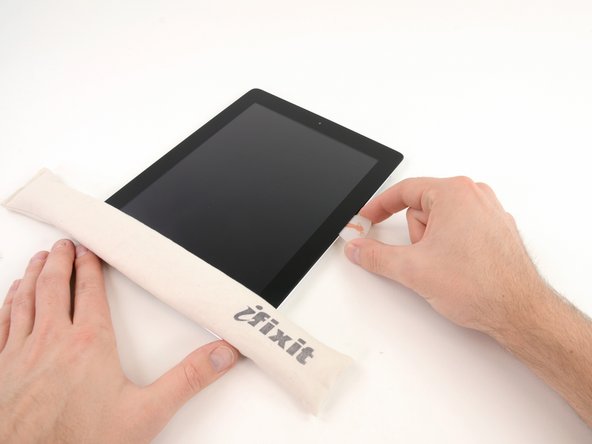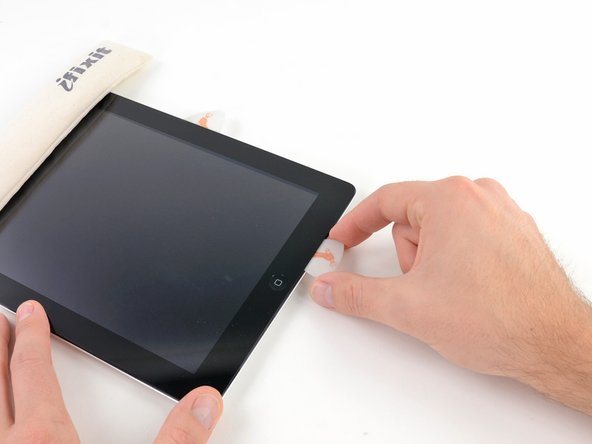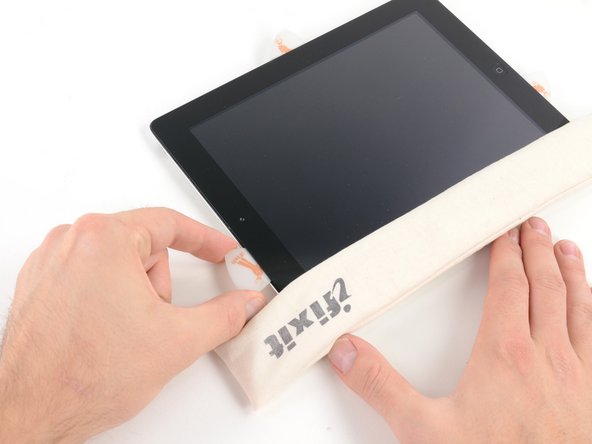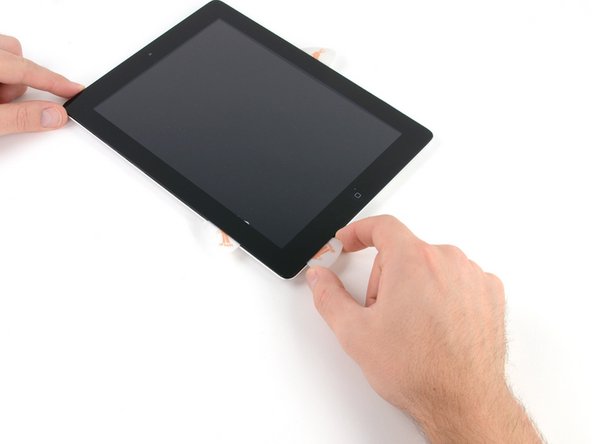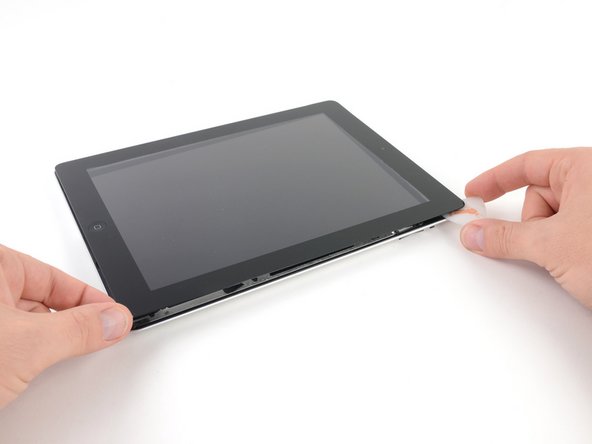iPad 2 GSM Microphone Replacement
Duration: 45 minutes
Steps: 45 Steps
Ready to swap out that busted microphone? This guide's got you covered. We've used a Wi-Fi model for some shots, so the internals might look a little different compared to the cellular model, but no worries – the process is exactly the same, with a few exceptions noted along the way. Let's get your device sounding great again!
Step 1
For carousel microwaves: Make sure the plate spins like it’s on a dance floor! If your iOpener gets stuck, it could overheat and cause some serious drama. Keep it moving for a smooth, safe cooking experience.
We suggest giving your microwave a little TLC before diving in, as any leftover gunk on the bottom could cling to your iOpener like an unwanted guest.
- Pop the iOpener right in the middle of the microwave like a champ!
Tools Used
Step 2
Be careful not to overheat the iOpener during the repair. Overheating could cause it to burst, and that's not the kind of drama we need. Aim for no more than 100˚C (212˚F).
If the iOpener is looking a little too puffed up, just leave it alone. Don't touch it!
If the iOpener is still too hot to handle, just chill for a bit. Let it cool down a little, then give it another go. A properly heated iOpener stays warm for about 10 minutes.
Depending on your microwave's wattage, you might need a little more or less time. The iOpener is good to go when it's just shy of too hot to handle.
- Give your iOpener a warm-up in the microwave for about thirty seconds. Just like your morning coffee, it needs a little heat to get going!
- As you continue with your repair, keep an eye on that iOpener! If it starts to cool down, pop it back in the microwave for another thirty seconds to keep the good vibes going.
Tools Used
Step 3
Caution! The iOpener gets super toasty, so be sure to handle it with care. An oven mitt might be your best buddy here!
- Carefully take the iOpener out of the microwave, making sure to grab it by one of the flat ends to keep away from that hot center. No one likes a surprise burn!
Tools Used
Step 4
Heads up! The iOpener gets super hot, so make sure to grab it only by the end tabs to keep your fingers safe.
No microwave? No problem! Just heat your iOpener by dipping it in boiling water instead.
- Grab a pot or pan and fill it up with enough water to give your iOpener a nice, warm bath.
- Bring that water to a rolling boil and then turn off the heat—safety first!
- Carefully drop your iOpener into the hot water for about 2-3 minutes, making sure it’s fully submerged and soaking up the warmth.
- Using tongs (because we’re all about safety, right?), fish out the heated iOpener from its steamy spa.
- Give the iOpener a thorough drying with a towel to keep it nice and comfy.
- And voilà! Your iOpener is prepped and ready to go! If it needs another heat session, just repeat the hot water dance for another 2-3 minutes.
Tools Used
Step 5
- Grab a SIM eject tool or even an uncoiled paperclip and gently pop out the SIM card tray.
Step 6
- Gently slide the SIM tray out of its cozy spot and carefully remove it from your iPad 2.
- If you're swapping the SIM card, just pop it out of the tray and slot in the shiny new one.
Step 7
Pop on some safety glasses to keep those peepers safe, and handle the LCD screen with care to avoid any oops moments.
This keeps all the glass bits in check and adds some muscle when you’re prying and lifting the screen.
- If your display glass is cracked, make sure to keep things contained to avoid further breakage and any possible injury while you work. A simple way to do this is by taping the glass.
- Cover the iPad's screen with several overlapping strips of clear packing tape until it's fully protected. It's like putting a bandage on a scraped knee, but for your screen.
- Do your best to follow the guide as outlined. Keep in mind, once the glass is broken, it may continue to crack during the repair. If that happens, you might need to use a metal prying tool to carefully scoop the glass out.
Step 8
Heads up! You'll be handling some fragile glass parts during this procedure, so it's a smart idea to rock a pair of safety glasses to protect yourself from any unexpected glass shrapnel. Stay safe, and let's get to work!
- Place the iOpener flat along the right edge of your iPad, ensuring it makes solid contact with the surface. Smooth it out for the best results.
- Let that cozy bag rest on the iPad for about 90 seconds before you dive into opening the front panel.
Tools Used
Step 9
You might need to give it a little nudge to slide the tip of the opening tool between the glass and plastic. Take your time and work gently, wiggling the tool back and forth to ease it in.
- Spot the tiny gap in the iPad's adhesive ring at the upper right corner, about 2.0 inches (~5 cm) down from the top edge. This little opening is your entry point.
- Line up your tool with the mute button. Gently slip the tip of a plastic opening tool into the gap between the front glass and the plastic bezel. Just slide in the very tip—enough to create a slight crack and get things moving.
Step 10
- Ensure you slide that tool right into the sweet spot—nestled between the plastic display bezel and the front panel glass. You're doing great!
Step 11
- Gently wedge the tip of your plastic opening tool between the front glass and the plastic bezel, then slide a plastic opening pick into the gap right next to it to keep things moving smoothly.
Step 12
- Take that trusty plastic opening tool and gently slide it under the iPad's front glass, pushing the opening pick in a little deeper—aim for about 0.5 inches. You're doing great!
Step 13
- As you tackle the adhesive on the right side of the iPad, give the iOpener a little reheat love, and place it back on the bottom edge of the iPad for some extra warmth.
Tools Used
Step 14
The adhesive is pretty powerful, so you might need to apply some muscle here. Just take your time and work with care!
If you spot the tip of the opening pick peeking out from under the front glass, gently wiggle it out just a bit. Using the pick this far in won’t harm anything, but it might leave some sticky adhesive smudges on the LCD.
- While warming up the bottom edge with the iOpener, start gently peeling away the adhesive from the right side of the iPad.
- Carefully slide the opening pick down along the iPad’s edge, loosening the adhesive as you go.
Tools Used
Step 15
If the adhesive is being stubborn, you might need to give the heated iOpener a little extra love by placing it back on the right edge of the iPad as you peel away the sticky bits. This is all about how much time your iPad has had to cool down while you've been working on it.
- If the opening pick gets a little stuck in the adhesive, don’t stress! Just roll it along the side of the iPad and keep working on loosening that sticky stuff. It'll give way soon enough!
Tools Used
Step 16
- Before you pull out that first opening pick from the bottom corner of the iPad, slide a second pick under the right edge of the front glass to keep the adhesive from sticking back together.
- Warm up the iOpener again and shift it to the top edge of the iPad to keep things nice and flexible.
Tools Used
Step 17
The Wi-Fi antenna is snugged in at the bottom right edge of the iPad’s rear case, held by screws and a cable. Since it’s positioned just so, take your time and handle it with care to avoid any permanent oopsies to the antenna.
- Heads up! The next steps need you to channel your inner careful ninja.
- You'll need to gently free the adhesive holding the antenna to the front panel without messing up the sensitive parts connecting the antenna to the bottom of the iPad. Take it slow and follow along closely.
Step 18
Keep the pick from sliding past the bottom right corner—going further might mess up the Wi-Fi antenna, and we definitely don’t want that!
- Gently slide the opening pick around the bottom right corner of the iPad to loosen the adhesive holding it in place.
Step 19
As you glide the opening pick along the bottom right corner of the front panel, be cautious! The Wi-Fi antenna is lurking nearby, and if you’re not careful, it might just decide to take an unplanned vacation. Let's keep that connection strong and intact!
Don’t yank the pick all the way out from under the front glass—just wiggle it back a bit so about 1/8" (3 mm) of the tip stays tucked underneath.
- Gently slide the tip of your opening pick along the bottom edge of the iPad to carefully loosen the adhesive holding the Wi-Fi antenna in place.
Step 20
- Once you've danced past the Wi-Fi antenna (that's about 3 inches or 75 mm from the right edge, right near the home button), slide that opening pick back in all the way.
- Gently shimmy the pick to the right to free the adhesive that’s holding the Wi-Fi antenna to the front glass. You're doing great!
- Remember, the antenna is snugly attached to the bottom of the iPad with screws and a cable. This step is key to unhooking the antenna from the front panel, so when you lift off the panel, that antenna stays safe and sound.
Step 21
Give your iOpener a break! Heat it for just a minute at a time, and let it cool down for at least two minutes before firing it up again.
If the adhesive has cooled down too much along the bottom edge, give that iOpener a little love and reheat it to warm up the adhesive in your working area.
- Keep on peeling away that adhesive along the bottom of your iPad! Make sure to pull the opening pick out just enough to navigate around the home button, then pop it back in until it's about 1/2 inch (10 mm) deep, once you're clear of the home button. You're doing great!
Tools Used
Step 22
When working on iPad 4 models, slide your pick no deeper than 1/2 inch (10 mm) here to keep that home button ribbon cable safe and sound.
- Keep peeling off the adhesive all along the bottom edge of the iPad like a pro.
- Leave the opening pick tucked under the front glass near the home button to keep things steady.
Step 23
- Pop the iOpener back in the microwave to warm it up, then place it on the left edge of the iPad to gently heat up the adhesive in that spot.
Tools Used
Step 24
If the adhesive has cooled off too much, just pop the iOpener back on the top edge and keep at it. If the iOpener itself has cooled down, give it a quick reheat and you’re good to go.
- Gently slide the opening pick along the top edge of the iPad, easing it out carefully as you navigate around the front-facing camera bracket.
- Heads up: the adhesive here is super sticky and thick, so you might need to apply a bit of muscle. Take it slow and steady to avoid slips or any accidental damage to you or your iPad.
- If the pick starts to get stuck in the adhesive, try "rolling" it as demonstrated in step 9 to keep things moving smoothly.
Tools Used
Step 25
If the adhesive feels nice and warm, go ahead and set the iOpener aside for now. But if it’s still sticking like glue, just heat it up again and rest it on the left edge while you keep working your magic.
- Keep peeling back the adhesive along the top edge of the iPad, and gently slide your opening pick around the top left corner like a pro.
Tools Used
Step 26
The digitizer cable sits about 2" (50 mm) from the bottom edge of the iPad. When you're sliding the pick in, pause once you hit roughly 2.25" (60 mm) from the bottom to keep things safe and sound.
- Gently slide the opening pick along the left edge of the iPad to loosen the adhesive as you go. Keep in mind, the adhesive here is pretty thin because of the digitizer running down the left side. Be sure not to push the pick too deep (around 10mm max), or you might accidentally damage the digitizer. Take it slow and steady!
Step 27
Be super careful! The digitizer cable is hanging out just about an inch (25 mm) away from the bottom of the iPad. Take your time and handle it gently, so we don’t accidentally cut that little guy!
- With your trusty opening pick still nestled under the bottom edge of the iPad, gently coax the adhesive loose at the bottom left corner. You've got this!
Step 28
Sometimes the adhesive around the edge of the iPad can sneak back and stick again. If that happens, gently slide a pick under the part of the front glass still holding tight and carefully 'cut' through the adhesive to free it up.
- Grab an opening pick and gently lift the bottom right corner of the iPad. Once it’s up, use your fingers to hold it in place.
Step 29
Watch out for any leftover adhesive, and grab an opening pick to gently slice through any sticky spots still holding that front panel in place. No rush, just take it slow and steady!
- Grab your iPad by the top and bottom right corners and give it a little twist to gently lift the front glass away from the device.
- When you're putting everything back together, use a microfiber cloth and some compressed air to wipe off any dust or smudges from the LCD before setting that glass back in place.
Step 30
- Take out those four 2.0 mm Phillips screws that are holding the LCD snugly against the rear case. You've got this!
Step 31
- Gently lift the LCD from the long side nearest the volume buttons, then swing it out from the rear case like opening a cool secret panel.
- Set the LCD down on the front panel just like in the second photo, keeping it safe and sound while you work.
Step 32
Make sure to gently lift the hinged retaining flap and not the socket itself. You've got this!
- Gently use the flat end of a plastic opening tool to flip up the little retaining flap on the headphone jack and front-facing camera ribbon cable ZIF socket.
- Slide a plastic opening tool underneath the headphone jack and front-facing camera cable to loosen it from the adhesive holding it to the rear panel.
- Carefully pull the headphone jack and front-facing camera ribbon cable straight out from its socket on the logic board.
Step 33
- Unscrew the three 2 mm Phillips screws that are holding the SIM slot in place on the back panel. You've got this!
Step 34
- Unscrew the two 2.9 mm Phillips screws holding the headphone jack to the back panel—easy does it!
Step 35
Hold your horses! Don’t pull the assembly out just yet.
- Grab a plastic opening tool and gently pry the headphone jack out from its snug spot along the top edge of your iPad.
Step 36
- Gently unstick the front camera and microphone cables from the rear panel.
Step 37
- Gently peel back the tape that's keeping the front camera cable connector snug as a bug.
- With the finesse of a pro, use a plastic opening tool's edge to detach the front camera cable from its buddy, the headphone jack cable.
Step 38
- Gently lift the front camera cable away from the bottom ribbon cable that’s connected to the headphone jack. You've got this!
Step 39
Watch out! Gently peel off the tape without making the camera, microphone, or headphone jack ribbon cables throw a fit.
- Peel off the piece of tape that's giving you the side-eye, highlighted in red. You got this!
Step 40
- Gently lift the front camera away from the foam adhesive that’s holding it to the back panel.
Step 41
- Gently coax the front-facing camera cable out from its cozy spot in the rear panel's channel.
- Carefully detach the front-facing camera from your iPad, making sure it feels loved on the way out.
Step 42
- Peel off the last bit of that foam tape hiding the microphone ribbon cable. You've got this!
Step 43
- Gently pry up the microphone cable connector using the edge of a plastic opening tool to unplug it without any drama.
Step 44
- Gently lift the microphone off the top edge of the rear panel, taking care to be delicate and precise.
Step 45
Watch out for that ribbon cable! It can be a sneaky little rascal and might try to catch a ride with the microphone while you're removing it. Keep an eye out so it doesn't tear!
- To put your device back together, simply reverse these steps and use our iPad 2 GSM Front Panel Adhesive strips guide to stick the front panel back on. If you get stuck or want a hand, you can always schedule a repair!




























